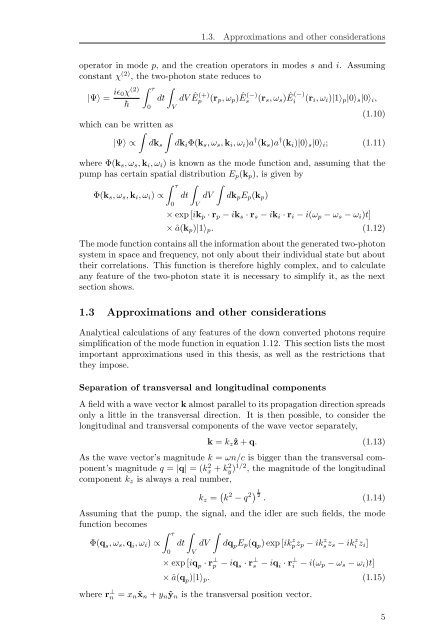Spatial Characterization Of Two-Photon States - GAP-Optique
Spatial Characterization Of Two-Photon States - GAP-Optique
Spatial Characterization Of Two-Photon States - GAP-Optique
Create successful ePaper yourself
Turn your PDF publications into a flip-book with our unique Google optimized e-Paper software.
1.3. Approximations and other considerations<br />
operator in mode p, and the creation operators in modes s and i. Assuming<br />
constant χ (2) , the two-photon state reduces to<br />
(2) τ <br />
iɛ0χ<br />
|Ψ〉 = dt dV<br />
0 V<br />
Ê(+) p (rp, ωp) Ê(−) s (rs, ωs) Ê(−) i (ri, ωi)|1〉p|0〉s|0〉i,<br />
(1.10)<br />
which can be written as<br />
<br />
|Ψ〉 ∝ dks dkiΦ(ks, ωs, ki, ωi)a † (ks)a † (ki)|0〉s|0〉i; (1.11)<br />
where Φ(ks, ωs, ki, ωi) is known as the mode function and, assuming that the<br />
pump has certain spatial distribution Ep(kp), is given by<br />
τ <br />
Φ(ks, ωs, ki, ωi) ∝ dt dV dkpEp(kp)<br />
0<br />
V<br />
× exp [ikp · rp − iks · rs − iki · ri − i(ωp − ωs − ωi)t]<br />
× â(kp)|1〉p. (1.12)<br />
The mode function contains all the information about the generated two-photon<br />
system in space and frequency, not only about their individual state but about<br />
their correlations. This function is therefore highly complex, and to calculate<br />
any feature of the two-photon state it is necessary to simplify it, as the next<br />
section shows.<br />
1.3 Approximations and other considerations<br />
Analytical calculations of any features of the down converted photons require<br />
simplification of the mode function in equation 1.12. This section lists the most<br />
important approximations used in this thesis, as well as the restrictions that<br />
they impose.<br />
Separation of transversal and longitudinal components<br />
A field with a wave vector k almost parallel to its propagation direction spreads<br />
only a little in the transversal direction. It is then possible, to consider the<br />
longitudinal and transversal components of the wave vector separately,<br />
k = kzˆz + q. (1.13)<br />
As the wave vector’s magnitude k = ωn/c is bigger than the transversal component’s<br />
magnitude q = |q| = (k 2 x + k 2 y) 1/2 , the magnitude of the longitudinal<br />
component kz is always a real number,<br />
kz = k 2 1<br />
− q<br />
2 2 . (1.14)<br />
Assuming that the pump, the signal, and the idler are such fields, the mode<br />
function becomes<br />
τ <br />
Φ(qs, ωs, qi, ωi) ∝<br />
0<br />
dt dV<br />
V<br />
dqpEp(qp) exp [ik z pzp − ik z szs − ik z i zi]<br />
× exp [iq p · r ⊥ p − iq s · r ⊥ s − iq i · r ⊥ i − i(ωp − ωs − ωi)t]<br />
× â(q p)|1〉p. (1.15)<br />
where r ⊥ n = xnˆxn + ynˆyn is the transversal position vector.<br />
5



